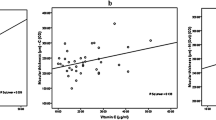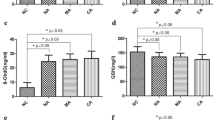Abstract
Purpose
The diabetic nephropathy is associated with oxidative stress and increases in pigment epithelium-derived factor (PEDF) level in the patient’s blood. For the first time, authors investigated the effect of methylethylpiridinol addition to the therapy on oxidative status and pigment epithelium-derived factor concentrations, and examined the relationship between these indicators and clinical markers of pathology development.
Methods
Study design: open label randomized controlled trial study. Authors assessed the effect of methylethylpiridinol addition to the therapy vs basic treatment on antioxidant and NADPH-generating enzymes activity, glutathione’s concentration and free radical-induced oxidation’s intensity using a spectrophotometric method and iron-induced biochemiluminescence. The pigment epithelium-derived factor concentration in the serum was measured by enzyme-linked immunosorbent assay.
Results
Patients receiving combination therapy with methylethylpiridinol showed a more substantial increase in activity of glutathione peroxidase (Δ = 0.04 ± 0.11, p = 0.002), glutathione transferase (Δ = 0.12 ± 0.08, p < 0.001) and the concentration of reduced glutathione (Δ = 0.30 ± 0.17, p = 0.039). In addition, there was a significant decrease in PEDF level (Δ = -6.4 ± 5.4, p = 0.004). Correlation analysis showed a negative link between Δ postprandial glucose and Δ NADP-isocitrate dehydrogenase (-0.39, p = 0.033), Δ reduced glutathione and Δ postprandial glucose (-0.372, p = 0.043), Δ glutathione transferase and Δ PEDF (-0.37, p = 0.044).
Conclusions
The methylethylpiridinol addition to the therapy had a more potent stimulating effect on the patients’ oxidative status in comparison with standard treatment, and reliably decreased pigment epithelium-derived factor level in patients’ serum. The observed differences seem to be associated with the antioxidant activity of methylethylpiridinol which contributing to the mitigation of oxidative stress reducing at diabetes mellitus.

Similar content being viewed by others
Data availability
The datasets generated during and/or analyzed during the current study are available from the corresponding author on reasonable request.
References
Gnudi L, Coward RJM, Long DA. Diabetic Nephropathy: Perspective on Novel Molecular Mechanisms. Trends Endocrinol Metab. 2016;27:820–30.
Miranda-Díaz AG, Pazarín-Villaseñor L, Yanowsky-Escatell FG, Andrade-Sierra J. Oxidative Stress in Diabetic Nephropathy with Early Chronic Kidney Disease. J Diabetes Res. 2016;2016:7047238.
Bansal S, Siddarth M, Chawla D, Banerjee BD, Madhu SV, Tripathi AK. Advanced glycation end products enhance reactive oxygen and nitrogen species generation in neutrophils in vitro. Mol Cell Biochem. 2012;361:289–96.
Lushchak VI. Glutathione homeostasis and functions: potential targets for medical interventions. J AminoAcids. 2012;2012:736837.
Kotova JuA, Zuikova AA, Pashkov AN, Strahova NV, Krasnorutskaya ON. Relationship between indices of oxidative stress, endothelial dysfunction and chaperone activity and the severity of coronary atherosclerosis. International Journal of Biomedicine. 2018;8:182–185.
Martos-Maldonado MC, Casas-Solvas JM, Vargas-Berenguel A, García-Fuentes L. Electrochemical detection of glutathione-S-transferase: an important enzyme in the cell protective mechanism against oxidative stress. Methods Mol Biol. 2015;1208:123–38.
Nóbrega-Pereira S, Fernandez-Marcos PJ, Brioche T, Gomez-Cabrera MC, Salvador-Pascual A, Flores JM, et al. G6PD protects from oxidative damage and improves health span in mice. Nat Commun. 2016;7:10894.
Medvedeva LV, Popova TN, Artyukhov VG, Matasova LV, Pinheiro de Carvalho MAA. Intensity of free radical processes and regulation of cytoplasmic NADP-isocitrate dehydrogenase in rat cardiomyocytes under normal and ischemic conditions. Biochemistry (Moscow). 2002;67:696–705.
Cheung CYY, Lee CH, Tang CS. Genetic Regulation of Pigment Epithelium-Derived Factor (PEDF): An Exome-Chip Association Analysis in Chinese Subjects With Type 2 Diabetes. Diabetes. 2019;68:198–206.
Voelker J, Berg PH, Sheetz M, Duffin K, Shen T, Moser B, Greene T, Blumenthal SS, Rychlik I, Yagil Y, Zaoui P, Lewis JB. Anti-TGF-β1 Antibody Therapy in Patients with Diabetic Nephropathy. J Am Soc Nephrol. 2017;28:953–62.
Volchegorskii IA, Miroshnichenko IY, Rassokhina LM, Faizullin RM, Pryakhina KE. Anxiolytic and antidepressant effects of emoxipine, reamberin and mexidol in experimental diabetes mellitus. ZhNevrolPsikhiatrIm S SKorsakova. 2017;117:52–7.
Julious SA. Tutorial in biostatistics. Sample sizes for clinical trials with Normal data. Statist. Med. 2004;23: 1921–1986.
Piskarev IM, Trofimova SV, Ivanova IP, Burkhina OE. Investigation of the level of free-radical processes in substrates and biological samples using induced chemiluminescence. Biophysics. 2015;60:400–8.
Ellman GL. Tissue sulfhydryl groups Arch BiochemBiophys. 1959;82:70–7.
Sifuentes-Franco S, Padilla-Tejeda DE, Carrillo-Ibarra S, Miranda-Díaz AG. Oxidative Stress, Apoptosis, and Mitochondrial Function in Diabetic Nephropathy. Int J Endocrinol. 2018;2018:1875870.
Peresypkina A, Pazhinsky A, Pokrovskii M, Beskhmelnitsyna E, Pobeda A, Korokin M. Correction of Experimental Retinal Ischemia by l-Isomer of Ethylmethylhydroxypyridine Malate. Antioxidants (Basel). 2019;8:E34.
Scherbinina SP, Levina AA, Lisovskaya IL, Ataullakhanov FI. Effect of exogenous antioxidants on erythrocyte redox status and hepcidin content in disorders of iron metabolism regulation. Biochemistry (Moscow) Supplement Series B: Biomedical Chemistry. 2012;6:338–342.
Loznikova SG, Sukhodola AA, ShcharbinaNYu, Shcharbin DG. The effects of magnesium, acetylsalicylic acid, and emoxypine on platelet aggregation. Biophysics. 2015;59:900–903.
He X, Cheng R, Benyajati S, Ma JX. PEDF and its roles in physiological and pathological conditions: implication in diabetic and hypoxia-induced angiogenic diseases. Clin Sci (Lond). 2015;128:805–23.
Ishibashi Y, Matsui T, Taira J, Higashimoto Y, Yamagishi S. Protective Role of PEDF-Derived Synthetic Peptide Against Experimental Diabetic Nephropathy. HormMetab Res. 2016;48:613–9.
Rubin A, Salzberg AC, Imamura Y, Grivitishvilli A, Tombran-Tink J. Identification of novel targets of diabetic nephropathy and PEDF peptide treatment using RNA-seq. BMC Genomics. 2016;17:936.
He Y, Leung KW, Ren Y, Pei J, Ge J, Tombran-Tink J. PEDF improves mitochondrial function in RPE cells during oxidative stress. Invest Ophthalmol Vis Sci. 2014;55:6742–55.
Yamagishi S, Nakamura K, Ueda S, Kato S, Imaizumi T. Pigment epithelium-derived factor (PEDF) blocks angiotensin II signaling in endothelial cells via suppression of NADPH oxidase: a novel anti-oxidative mechanism of PEDF. Cell Tissue Res. 2005;320:437–45.
Yoshida T, Akiba J, Matsui T, Nakamura K, Hisamoto T, Abe M, Ikezono Y, Wada F, Iwamoto H, Nakamura T, Koga H, Yamagishi SI, Torimura T. Pigment Epithelium-Derived Factor (PEDF) Prevents Hepatic Fat Storage, Inflammation, and Fibrosis in Dietary Steatohepatitis of Mice. Dig Dis Sci. 2017;62:1527–36.
Li XH, Wang HP, Tan J, Wu YD, Yang M, Mao CZ, Gao SF, Li H, Chen H, Cai WB. Loss of pigment epithelium-derived factor leads to ovarian oxidative damage accompanied by diminished ovarian reserve in mice. Life Sci. 2019;216:129–39.
Hui E, Yeung CY, Lee PC, Woo YC, Fong CH, Chow WS, Xu A, Lam KS. Elevated circulating pigment epithelium-derived factor predicts the progression of diabetic nephropathy in patients with type 2 diabetes. J Clin Endocrinol Metab. 2014;99:E2169-2177.
Al-Waili N, Al-Waili H, Al-Waili T, Salom K. Natural antioxidants in the treatment and prevention of diabetic nephropathy; a potential approach that warrants clinical trials. Redox Rep. 2017;22:99–118.
Matsuyama K, Ogata N, Matsuoka M, Shima C, Wada M, Jo N, Matsumura M. Relationship between pigment epithelium-derived factor (PEDF) and renal function in patients with diabetic retinopathy. Mol Vis. 2008;14:992–6.
Xu Y, Osborne BW, Stanton RC. Diabetes causes inhibition of glucose-6-phosphate dehydrogenase via activation of PKA, which contributes to oxidative stress in rat kidney cortex. Am J Physiol Renal Physiol. 2005;289:F1040-1047.
Lai YK, Lai NM, Lee SW. Glucose-6-phosphate dehydrogenase deficiency and risk of diabetes: a systematic review and meta-analysis. Ann Hematol. 2017;96:839–45.
Funding
This study was not supported by any funds.
Conflicts of interest/Competing interests. No conflicts of interest have been declared.
Author information
Authors and Affiliations
Corresponding author
Ethics declarations
Ethics approval
All procedures performed in studies involving human participants were in accordance with the ethical standards of the institutional and/or national research committee and with the 1964 Helsinki declaration and its later amendments or comparable ethical standards. The research was approved by the Ethics Committee of the Voronezh State Medical University named after N.N. Burdenko, the extract from the protocol No.4 of September 29, 2016.
Consent to participate
Informed consent was obtained from all individual participants included in the study.
Conflicts of interest
On behalf of all authors, the corresponding author states that there is no conflict of interest.
Additional information
Publisher's Note
Springer Nature remains neutral with regard to jurisdictional claims in published maps and institutional affiliations.
Rights and permissions
About this article
Cite this article
Popov, S.S., Anufrieva, E.I., Kryl’skii, E.D. et al. The effect of methylethylpiridinol addition to the therapy on the level of pigment epithelium-derived factor and oxidative status in patients with diabetic nephropathy: randomized controlled open-label clinical study. J Diabetes Metab Disord 20, 709–717 (2021). https://doi.org/10.1007/s40200-021-00802-6
Received:
Accepted:
Published:
Issue Date:
DOI: https://doi.org/10.1007/s40200-021-00802-6




